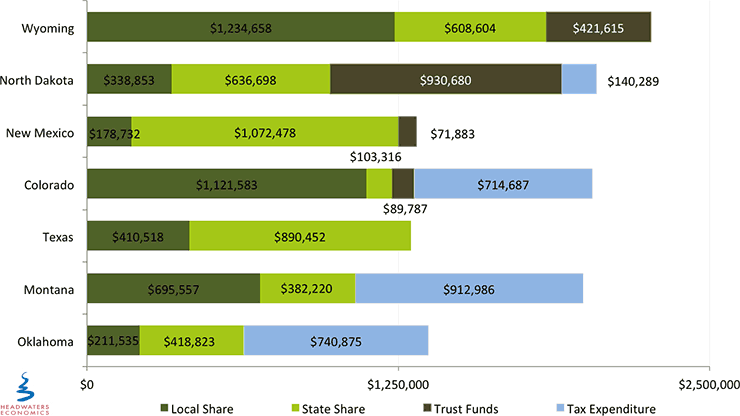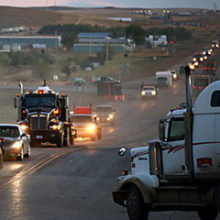Fiscal policy is important for local communities for several reasons. This analysis shows that many North Dakota communities are not receiving the resources necessary to manage impacts during the boom or to ensure resources are available after the boom. The North Dakota report is part of a larger series that looks at seven states: Colorado, Montana, New Mexico, North Dakota, Oklahoma, Texas, and Wyoming.
The focus on unconventional oil is important as horizontal drilling and hydraulic fracturing technologies have led a resurgence in oil production in the U.S. Unconventional oil plays require more wells to be drilled on a continuous basis to maintain production than comparable conventional oil fields. This expands potential employment, income, and tax benefits, but also heightens and extends public costs.
Mitigating the acute impacts associated with drilling activity and related population growth requires that revenue is available in the amount, time, and location necessary to build and maintain infrastructure and to provide services. In addition, managing volatility over time requires different fiscal strategies, including setting aside a portion of oil revenue in permanent funds.
Summary Findings
- North Dakota’s effective tax rate ranks second (after Wyoming) among the seven oil-producing states we compare. North Dakota levies two production taxes at the state level with a combined “base” tax rate of 11.5 percent. As a result of incentives and deductions, the effective tax rate over ten years of production from a typical unconventional oil well is 11.2 percent (see Figure 1 below).
- North Dakota’s revenue allocations are regressive with respect to community distributions. Local governments retain the first $5 million generated from the gross production tax, but only 25 percent of additional revenue generated locally during each biennium. Counties with the most oil production receive the most revenue, in absolute terms, but retain a declining share as tax receipts climb.
- North Dakota is in the middle of returning tax collections to local governments. Four of the seven states (Colorado, Montana, Texas, and Wyoming) return a greater share of revenue collections to local governments than North Dakota (see Figure 2 below).
- North Dakota is one of two states (the other is Colorado) that make direct distributions to cities based on the location of drilling and population-related impacts. It is more common to make distributions to jurisdictions based solely on where production takes place.
- North Dakota saves the largest amount and share of total revenue (about 46% into the Legacy Fund) compared to other energy-producing states. How the proceeds will be spent is still undetermined.
Figure 1. Comparison of Production Tax Revenue Collected from a Typical Unconventional Oil Well

Figure 2. Comparison of Distribution of Production Tax Revenue from a Typical Unconventional Oil Well

Background
Unconventional oil is extracted from tight shale formations using horizontal drilling and hydraulic fracturing technologies. The focus on unconventional oil is important as horizontal drilling and hydraulic fracturing technologies have led a resurgence in oil production in the U.S. Unconventional oil plays require more wells to be drilled on a continuous basis to maintain production than comparable conventional oil fields. This expands potential employment, income, and tax benefits, but also heightens and extends impacts on communities and public costs.
State and local governments levy different types of production taxes, at different rates, and offer a complex array of exemptions, deductions, and incentives. The various approaches to taxing oil and natural gas make comparisons between states difficult, although not impossible. This report applies each state’s fiscal policy, including production taxes and revenue distributions, to a typical new unconventional oil well over ten years of production. This allows for a comparison of how states tax oil extracted using unconventional technologies, and how this revenue is distributed to communities over time.
To provide a simple framework for the comparison, we assess state production tax policies on four criteria: the amount, time, location, and predictability of revenue distributions to local governments where extraction and associated impacts occur. We also provide a summary of the methods and data used to compare state fiscal policies.
The various approaches to taxing oil make comparisons between states difficult, although not impossible. To compare states, we apply each state’s fiscal policy, including production taxes and revenue distributions, to a typical unconventional oil well. This allows for a comparison of how states tax oil extracted using unconventional technologies, and how this revenue is distributed to communities.
We hope these data and resources will be useful to states and communities with unconventional oil development that are trying to mitigate the short-term impacts of oil extraction while making investments in long-term economic development opportunities.




